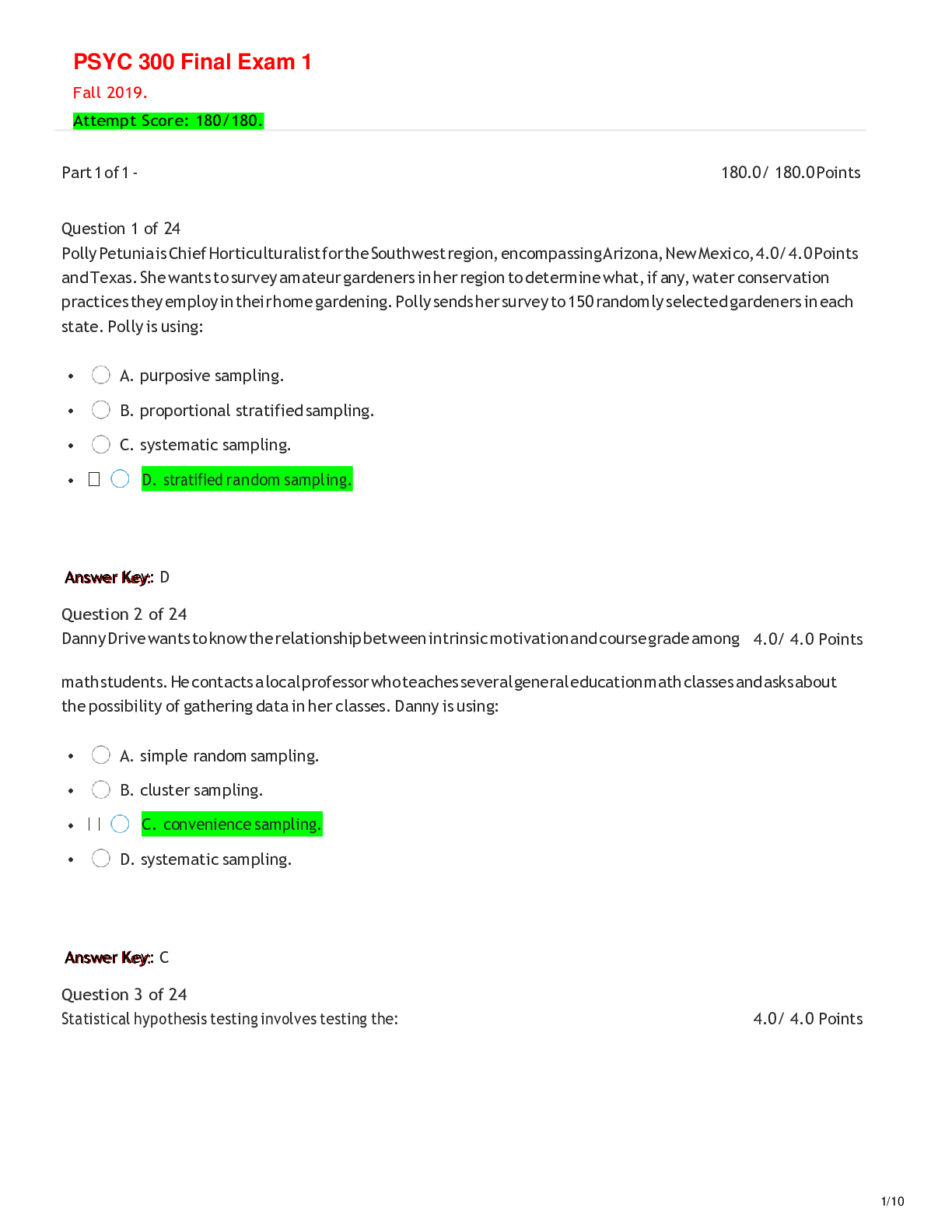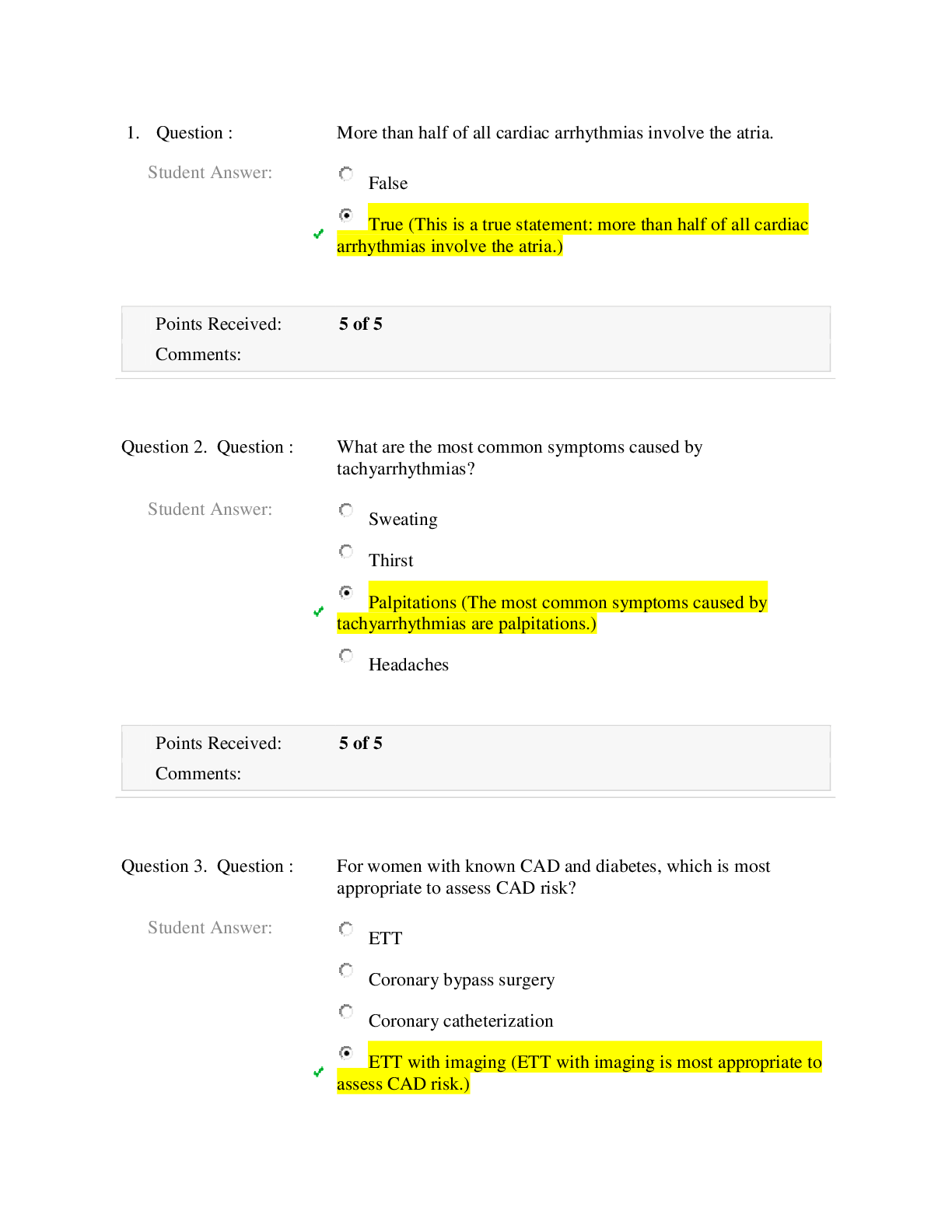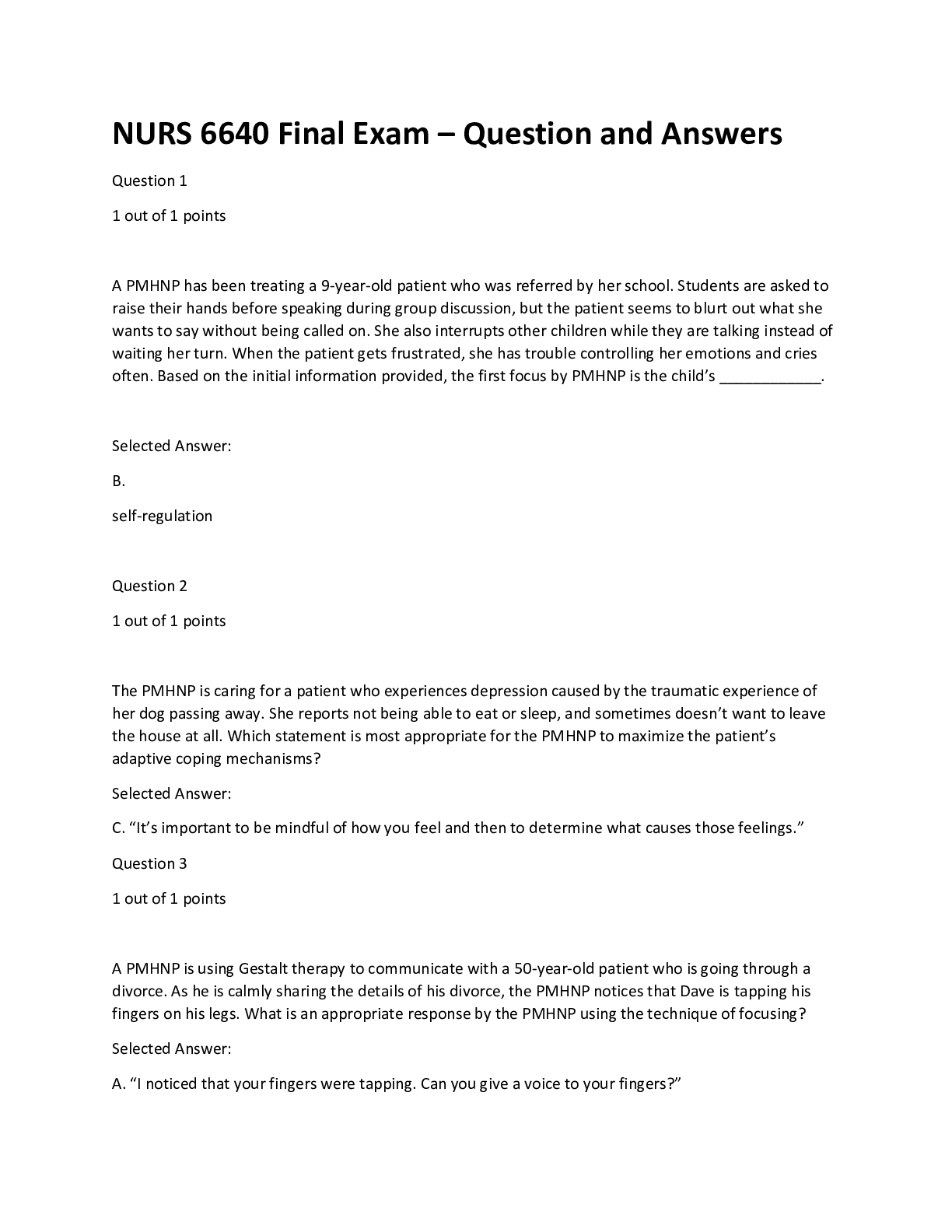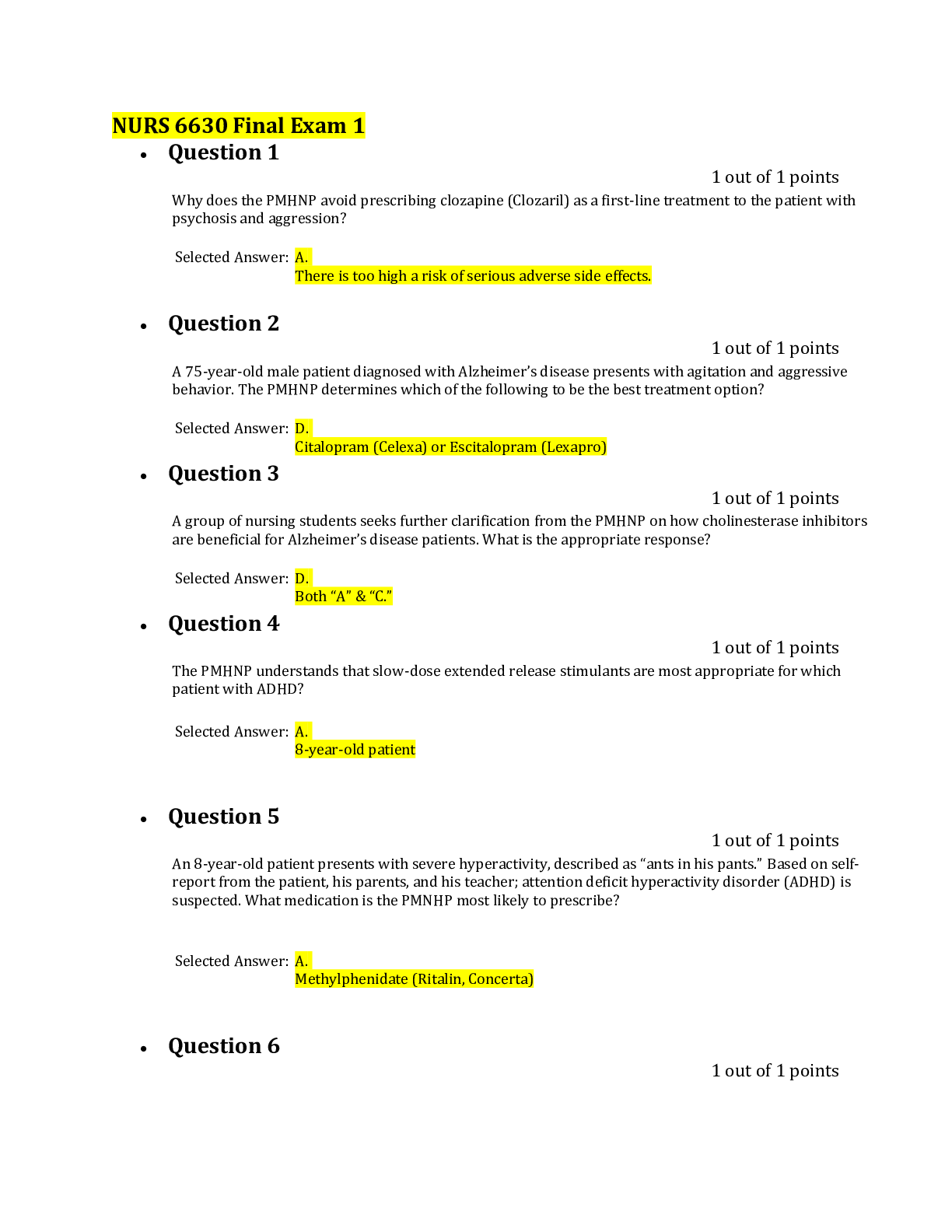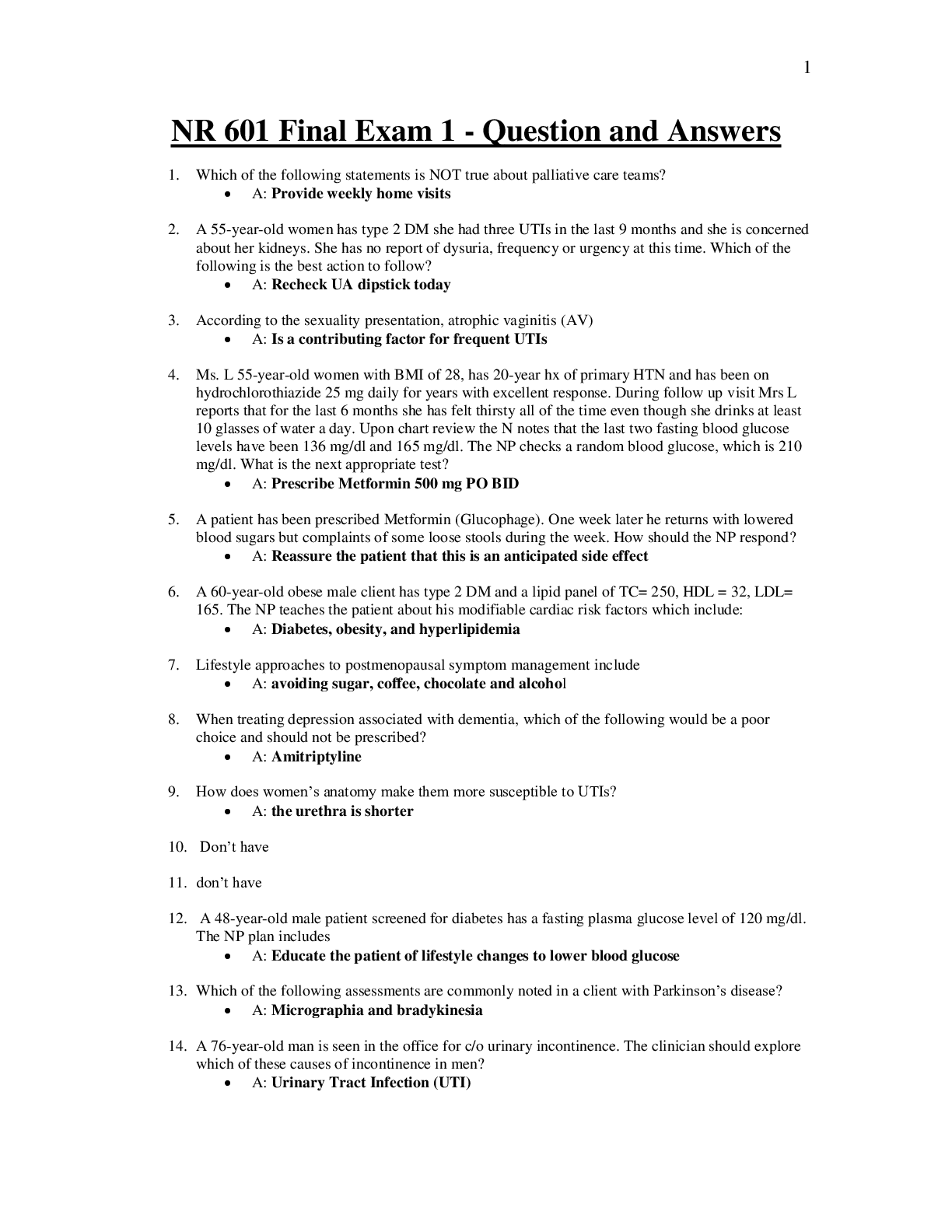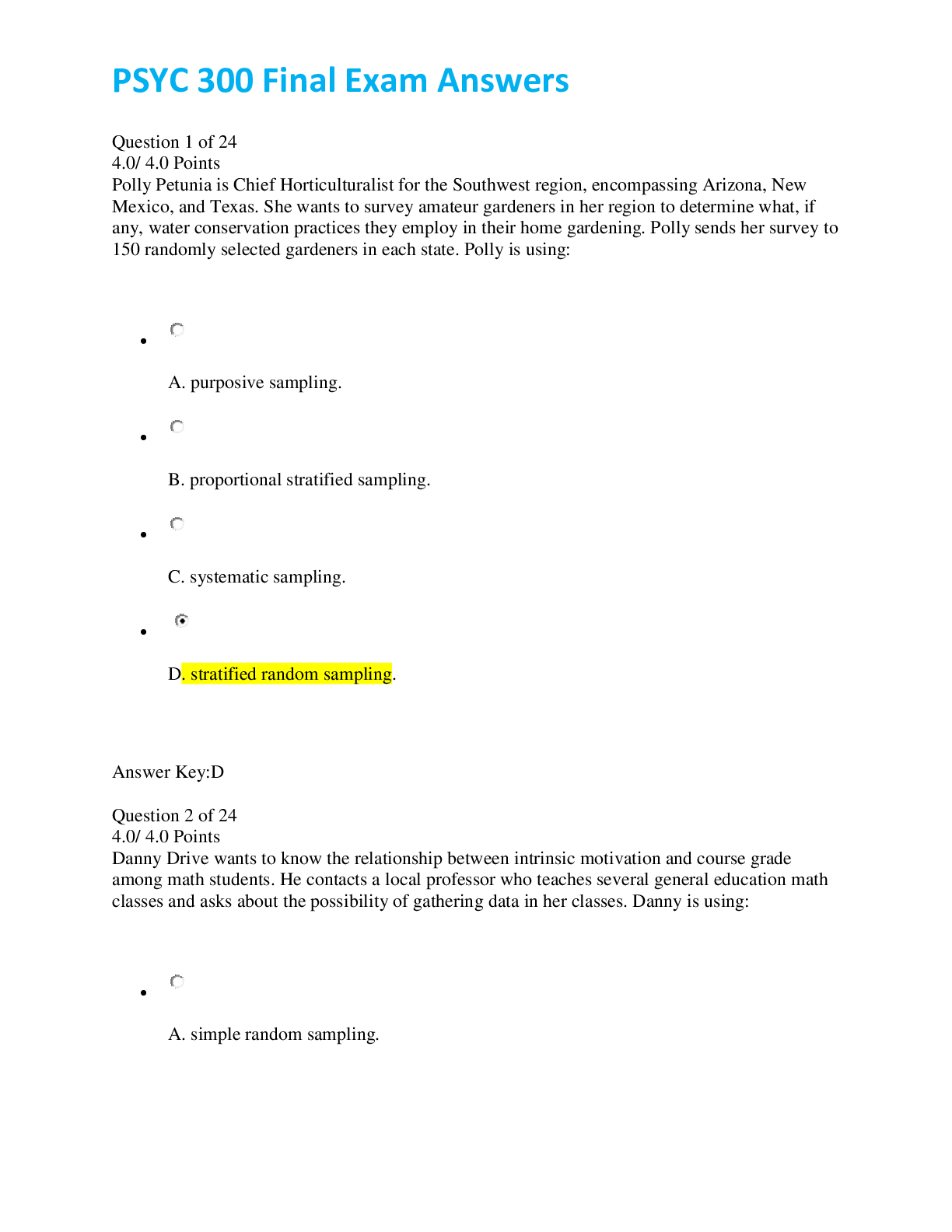NSG 6430 Final Exam 1 - Womens Health_LATEST 2020 (Q&A)100% CORRECT
Document Content and Description Below
he nurse practitioner knows that a highly valuable assessment tool for evaluating urinary incontinence and contributing factors in daily life is: 2. The nurse practitioner is counseling a 57 year-... old patient with urinary incontinence. The patient desires to try non-pharmacological, non-invasive methods of treatment at this time. Which of the following should be included in the patient's plan of care? Select all that apply. 3. The nurse practitioner is performing a bimanual exam on a new OB patient and notices that the lower portion of the patient’s uterus is soft. This is known as: 4. Your female patient presents for vaginal discharge with an odor, and has noticed painless “bumps” on her vaginal area. Sexual history includes past male partners and her current female partner. On exam you note beefy red papules and an ulcerative lesion on her vulva, granular tissue and scarring, and inguinal adenopathy. You suspect she has: 5. The physical examination of any woman suspected of being abused or battered includes all of the following except: 6. The most effective means of obtaining the history of abuse is to use a communication model that: 7. Clinicians should routinely consider intimate partner violence (IPV) as a possible diagnosis for women who present with all of the following except: 8. The factors that enable women to enjoy and control their sexual and reproductive lives, including a physical andemotional state of well-being and thequality of sexual and other close relationships, make up a woman's: 9. Which one of the following is not among the ways clinicians can provide a welcoming, safe environment for Lesbian, Gay, Bixsexual, or Transgender (LGBT) patients? 10. Which one of the following is the definition of the term "gender identity"? 11. Which one of the following statements about sexually transmitted infections (STIs) is false? 12. Among the midlife health issues of women, the number one cause of mortality in the United States is: 13. Lifestyle approaches to manage menopause related vasomotor symptoms include: 14. The standard for managing moderate to severe menopausal symptoms is: 15. The nurse practitioner is managing an adolescent with a 4 cm functional ovarian cyst that was confirmed on a recent ultrasound. What plan of care should be anticipated for this patient? 16. Non-pharmacologic therapy for chronic pelvic pain includes the following: Select all that apply. 17. The nurse practitioner understands that all of the following organisms are responsible for infection of the Bartholin's gland except: 18. Treatment of a large, symptomatic Bartholin's cyst includes all of the following except: 19. A 44 year-old African American female presents with complaints of menorrhagia x 15 months. Pelvic ultrasound confirms the presence of a large intramural leiomyomata. The nurse practitioner should discuss all of the following options with the patient except: 20. The nurse practitioner is treating a patient with Elimite for scabies. The proper instructions to the patient should include: 21. The nurse practitioner understands that the proper management of an asymptomatic woman with a small fibroid should include: 22. The nurse practitioner is teaching a patient about pediculosis. Which of the following statements by the nurse practitioner is correct? 23. All of the following medications may be used for neuropathic pain management of vulvodynia, except: 24. The nurse practitioner understands that which of the following lab tests is appropriate for the patient who presents with symptoms of dysestheticvulvodynia? 25. Which of the following is a common antibiotic for treatment of an infected Bartholin's cyst? 26. The patient presents with complaints of a painful, swollen lump in her vaginal area. She reports difficulty sitting and walking due to the pain. Which of the following is a likely diagnosis for this patient? 27. The nurse practitioner understands that which of the following are differential diagnoses in an adult female patient with acute pelvic pain. Select all that apply: 28. When women experience mild premenstrual symptoms, such as mild breast tenderness, abdominal bloating, and mild weight gain from water retention, this is known as: 29. A patient with intraductal papilloma will commonly present with a chief complaint of: 30. The nurse practitioner understands that the necessary screening techniques in a patient suspicious of ovarian cancer should include the following: Select all that apply. 31. Early symptoms experienced by a woman with ovarian cancer include all of the following except: 32. The nurse practitioner is evaluating a patient's risk of ovarian cancer. All of the following factors are associated with an increased risk for ovarian cancer except: 33. Patient education for condylomataacuminata should include all the following except: 34. Tina is evaluated and diagnosed with Molluscum Contagiosum. The nurse practitioner understands that clinical presentation of this disease is characterized by: 35. Sara is 72 years old and has been a widow for 12 years. She presents for her yearly well woman exam. Sara has not been sexually active since age 60. She has had regular pap screenings in her life and has had no abnormal pap tests. Sara asks if she needs a Pap test. Your response would be: 36. Misty presents with a painful “sores” in her perineal area, dysuria and dyspareunia. On exam she has 2 shallow ulcerated lesions on the right labia majora and one on the left. She also presents with enlarged inguinal lymph nodes. Based on these findings you suspect she has: 37. Which of the following is not true for HIV infection evaluation? 38. The nurse practitioner understands that the risk factors for developing vaginal candidiasis include which of the following 39. Cindy presents to your clinic for STI testing after realizing her current boyfriend has been seeing other women. She states she was told that one of the women has hepatitis B. Your patient education regarding hepatitis B includes all the following except: 40. Stacy has made an appointment at your clinic for c/o dysuria. During the HPI she explains, “My bottom hurts when I pee, and I have bumps there”. She has never had this before and is worried. She denies fever, although she feels “a little like I have the flu” explaining she has a headache and feels achy and tired. She denies exposure to a STI noting she and her partner have been monogamous for 6 years. On exam you notice a cluster of painful vesicles adjacent to the vaginal introitus. The most likely diagnosis is: 41. You see an 18-year-old woman with a history of Chlamydia infection and a total of five lifetime partners. Based on the latest evidence-based guidelines, you recommend: 42. Karen was recently diagnosed with primary syphilis. The nurse practitioner understands that the first-line treatment option for primary syphilis include: 43. While educating Karen about the different stages of syphilis, which of the following is not representative of the presentation of secondary syphilis? 44. Karen was recently diagnosed with primary syphilis by her primary care provider, she is very upset and inquires how long after sexual contact do syphilis symptoms typically occur. What is the correct response by the primary care provider? 45. Which of the following terms describe the mechanism of action of Imiquimod (Aldara) in the management of genital warts? 46. The nurse practitioner understands that HPV types _____ and ____are most often associated with cervical and anogenital cancer. 47. Jenna was evaluated and diagnosed with condylomaacuminatum. Treatment options for Jenna will include all of the following except: 48. Which of the following is a treatment option for a 30-year-old woman with PID and a history of severe hive-form reaction when taking a penicillin or cephalosporin? 49. The nurse practitioner understands that a complication of gonoccocal and chlamydial genitourinary infection in women include which of the following: 50. The nurse practitioner understands that women with PID typically present with all of the following except: [Show More]
Last updated: 1 year ago
Preview 1 out of pages
Instant download

Buy this document to get the full access instantly
Instant Download Access after purchase
Add to cartInstant download
Reviews( 0 )
Document information
Connected school, study & course
About the document
Uploaded On
Oct 26, 2020
Number of pages
Written in
Additional information
This document has been written for:
Uploaded
Oct 26, 2020
Downloads
0
Views
8














